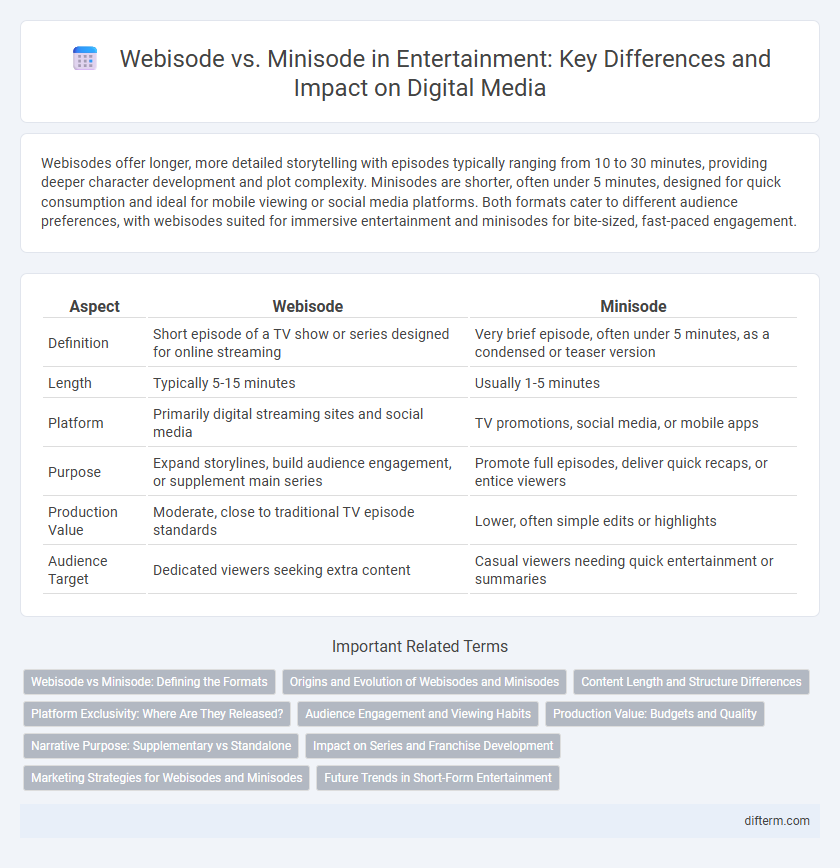Webisodes offer longer, more detailed storytelling with episodes typically ranging from 10 to 30 minutes, providing deeper character development and plot complexity. Minisodes are shorter, often under 5 minutes, designed for quick consumption and ideal for mobile viewing or social media platforms. Both formats cater to different audience preferences, with webisodes suited for immersive entertainment and minisodes for bite-sized, fast-paced engagement.
Table of Comparison
| Aspect | Webisode | Minisode |
|---|---|---|
| Definition | Short episode of a TV show or series designed for online streaming | Very brief episode, often under 5 minutes, as a condensed or teaser version |
| Length | Typically 5-15 minutes | Usually 1-5 minutes |
| Platform | Primarily digital streaming sites and social media | TV promotions, social media, or mobile apps |
| Purpose | Expand storylines, build audience engagement, or supplement main series | Promote full episodes, deliver quick recaps, or entice viewers |
| Production Value | Moderate, close to traditional TV episode standards | Lower, often simple edits or highlights |
| Audience Target | Dedicated viewers seeking extra content | Casual viewers needing quick entertainment or summaries |
Webisode vs Minisode: Defining the Formats
Webisodes are short episodic videos typically released online, often ranging from 5 to 15 minutes, designed to expand a show's storyline or offer exclusive content. Minisodes are even shorter, usually under 5 minutes, providing condensed or highly focused segments that highlight key moments or summaries. Both formats cater to digital audiences by delivering bite-sized entertainment, but webisodes generally allow for deeper narrative development compared to the brief, snapshot nature of minisodes.
Origins and Evolution of Webisodes and Minisodes
Webisodes originated in the early 2000s as short, internet-only episodes designed to complement traditional TV shows, leveraging the rise of broadband internet and online streaming platforms. Minisodes evolved from webisodes by offering even shorter content, typically under five minutes, to cater to mobile viewers' shrinking attention spans and on-the-go consumption. Both formats have transformed the entertainment landscape by enabling creators to experiment with narrative structures and engage audiences beyond conventional television schedules.
Content Length and Structure Differences
Webisodes typically range from 5 to 15 minutes, offering a fully developed narrative arc that mirrors traditional episodic storytelling on a smaller scale. Minisodes are much shorter, often under 5 minutes, focusing on quick, concise content that highlights key moments or side stories without elaborate plot development. Both formats cater to digital audiences but differ significantly in pacing and depth due to their distinct content length and structural design.
Platform Exclusivity: Where Are They Released?
Webisodes are typically released on official streaming platforms or social media channels affiliated with the original content creator, ensuring a seamless extension of the primary series. Minisodes often appear as exclusive content on specific digital platforms or apps, designed to attract niche audiences and enhance subscription value. Platform exclusivity increases engagement by targeting viewers where they already consume related entertainment content.
Audience Engagement and Viewing Habits
Webisodes cater to niche audiences by offering serialized storytelling with deeper character development, fostering stronger fan engagement and community interaction through episodic releases. Minisodes typically target casual viewers with concise, standalone content designed for quick consumption, aligning with on-the-go viewing habits and shorter attention spans. Both formats influence audience retention strategies by adapting to digital consumption trends, enhancing user experiences across social media and streaming platforms.
Production Value: Budgets and Quality
Webisodes typically have higher production values than minisodes, benefiting from larger budgets that allow for professional equipment, sets, and post-production effects, resulting in superior visual and audio quality. Minisodes often operate with limited budgets, relying on minimalistic settings and simpler editing to maintain cost efficiency while delivering concise storytelling. The disparity in funding directly impacts the overall polish and viewer experience, with webisodes generally offering a more cinematic presentation.
Narrative Purpose: Supplementary vs Standalone
Webisodes often serve a supplementary narrative purpose, enhancing the main storyline of a larger series by providing additional context or backstory. Minisodes are designed as standalone pieces with a concise plot that delivers a complete story in a shorter format. This distinction makes webisodes ideal for expanding viewer engagement, while minisodes cater to audiences seeking quick, self-contained entertainment.
Impact on Series and Franchise Development
Webisodes extend audience engagement by delivering short, focused content that deepens character development and expands storylines within a series' universe. Minisodes, often serving as condensed highlights or previews, boost viewer interest and accessibility, drawing in new fans while maintaining the loyalty of existing audiences. Both formats contribute strategically to franchise growth by sustaining momentum between major releases and enhancing cross-platform storytelling opportunities.
Marketing Strategies for Webisodes and Minisodes
Webisodes and minisodes serve different marketing strategies, with webisodes focusing on episodic storytelling to build sustained audience engagement and brand loyalty through serialized content distribution on digital platforms. Minisodes utilize concise, bite-sized episodes designed for quick consumption, maximizing shareability and viral potential on social media channels to boost brand visibility and attract new viewers. Both formats leverage targeted content marketing, with webisodes emphasizing deeper narrative immersion and minisodes prioritizing high-impact, easily digestible promotional messages.
Future Trends in Short-Form Entertainment
Webisodes and minisodes are shaping the future of short-form entertainment by catering to increasingly mobile and time-constrained audiences. Advances in streaming technology and AI-driven content personalization are driving the demand for compact, high-impact storytelling formats under five minutes. Industry projections indicate these bite-sized episodes will dominate digital platforms, offering interactive experiences and seamless integration with social media ecosystems.
Webisode vs minisode Infographic

 difterm.com
difterm.com